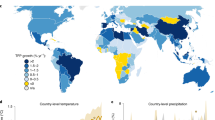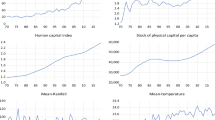Abstract
Total factor productivity (TFP) analysis has been the focus of a large number of methodological and empirical studies over the past several decades. One remarkable gap in this literature is the omission of climatic variables as regressors in the models used to derive TFP measures. The purpose of this paper is to narrow this gap by developing climate-adjusted (CA) TFP measures. We combine information from the Climatic Research Unit with Food and Agriculture Organization data for 28 Latin American and Caribbean countries over a 52-year period (1961–2012) to estimate random parameter stochastic production frontier (SPF) models. The goal is to investigate the impact of climatic variability on TFP. The estimated coefficients from the SPF models are used to construct a climatic effects index across countries and over time. The average annual variation in climatic conditions is stronger at the end of the 2000s compared to earlier periods. Climatic variability has a negative effect on production in 20 of the 28 LAC countries analyzed, and this is more severe over Central America and the Caribbean. The average reduction in output across the region attributable to climatic variables is between 0.02 and 22.7% over the last decade compared to the period 1961–1999. The estimated average annual growth rate of CATFP (0.69%) is consistently lower than TFP (1.08%), confirming the adverse impact of climatic variability on agricultural output and productivity in LAC. The results show considerable variability across countries, and this points to the importance of accounting for climatic effects in analyzing TFP.





Similar content being viewed by others
Notes
We exclude mean values because they do not capture variability.
The 28 countries in LAC include (1) Caribbean: The Bahamas, Cuba, Dominican Republic, Haiti, Jamaica, Puerto Rico, and Trinidad and Tobago; (2) Mexico and Central America: Mexico, Belize, Costa Rica, El Salvador, Guatemala, Honduras, Nicaragua, and Panama; and (3) South America: Argentina, Bolivia, Brazil, Chile, Colombia, Ecuador, French Guiana, Guyana, Paraguay, Peru, Suriname, Uruguay, and Venezuela.
See https://www.ncdc.noaa.gov/monitoring-references/dyk/anomalies-vs-temperature for more details.
For more details about the construction of the climatic variables, see Harris et al. (2013).
We perform multicollinearity tests for all conventional inputs and climatic variables using the “rmcoll” syntax in Stata 14 (Cameron and Travedi 2005). The evidence does not support the presence of multicollinearity.
We did not find evidence to support the inclusion of quadratic terms for climatic variability.
Over the 1961–2012 period, fertilizer use grew at the fastest annual rate (5.8%) relative to all other inputs, while land increased at 1.3% per year. Figure C in the online Supplementary material (Section E) shows the trends for all inputs used in our models.
References
Barrios S, Bertinelli L, Strobl E (2010) Trends in rainfall and economic growth in Africa: a neglected cause of the African growth tragedy. Rev Econ Stat 92(2):350–366
Bharati P, Fulginiti L (2007) Institutions and agricultural productivity in Mercosur. In: Teixeira EC, Braga MJ (eds) Institutions and economic development. Vicosa, Os Editores
Burke M, Emerick K (2016) Adaptation to climate change: evidence from US agriculture. Am Econ J Econ Pol 8(3):106–140
Cabas J, Weersink A, Olale E (2010) Crop yield response to economic, site and climatic variables. Clim Chang 101(3–4):599–616
Cameron AC, Trivedi PK (2005) Microeconometrics: methods and applications. Cambridge University Press, Cambridge
Chen CC, McCarl BA, Schimmelpfennig DE (2004) Yield variability as influenced by climate: a statistical investigation. Clim Chang 66(1–2):239–261
Chomitz KM, Buys P (2007) At loggerheads? Agricultural expansion, poverty reduction, and environment in the tropical forests. World Bank Publications, Washington
Chou C, Chen CA, Tan PH, Chen KT (2012) Mechanisms for global warming impacts on precipitation frequency and intensity. J Clim 25(9):3291–3306
Cleveland RB, Cleveland WS, McRae JE, Terpenning I (1990) STL: a seasonal-trend decomposition procedure based on loess. J Off Stat 6(1):3–73
Craigmile PF, Guttorp P (2011) Space-time modelling of trends in temperature series. J Time Ser Anal 32(4):378–395
Dell M, Jones BF, Olken BA (2014) What do we learn from the weather? The new climate-economy literature. J Econ Lit 52(3):740–798
Economic Commission for Latin America and the Caribbean (ECLAC) (2013) Economics of climate change in Central America—synthesis 2012. United Nations LC/MEX/L.1076. Mexico City, Mexico
Fishman RM (2011) Climate change, rainfall variability, and adaptation through irrigation: evidence from Indian agriculture. Columbia University, Columbia
Food and Agriculture Organization of the United Nations (FAO) (2010) Global forest resources assessment 2010: main report. FAO forestry paper no. 163. Food and Agriculture Organization of the United Nations, Rome
Food and Agriculture Organization of the United Nations (FAO) (2015) Global forest resources assessment, Second edn. Food and Agriculture Organization of the United Nations, Rome
Fuglie KO, Sun LW, Eldon BA (eds) (2012) Productivity growth in agriculture: an international perspective. CABI International, Oxfordshire
Geist HJ, Lambin EF (2002) Proximate causes and underlying driving forces of tropical deforestation: tropical forests are disappearing as the result of many pressures, both local and regional, acting in various combinations in different geographical locations. Bioscience 52(2):143–150
Greene WH (2005a) Reconsidering heterogeneity in panel data estimators of the stochastic frontier model. J Econ 126:269–303
Greene WH (2005b) Fixed and random effects in stochastic frontier models. J Prod Anal 23:7–32
Greene WH (2008) Econometric analysis. Prentice Hall, Englewood Cliffs
Greene WH (2012) LIMDEP version 10.0: user’s manual and reference guide. Econometric Software, New York
Harris I, Jones PD, Osborn TJ, Lister DH (2013) Updated high-resolution grids of monthly climatic observations—the CRU TS3.10 dataset. Int J Climatol 34(3):623–642
Hughes N, Lawson K, Davidson A, Jackson T, Sheng Y (2011) Productivity Pathways: climate-adjusted production frontiers for the Australian broadcare cropping industry. Australian Agricultural and Resource Economics Society Conference, 2011 Conference (55th), February 8–11, 2011, Melbourne, Australia
Inter-American Development Bank (IADB) and Economic Commission for Latin America and the Caribbean (ECLAC) (2014) Economic impacts of climate change in Colombia—synthesis. Calderón S, Romero G, Ordoñez A, Álvarez A, Ludeña CE, Sanchez-Aragon L, de Miguel C, Martínez K, Pereira M (eds) Inter-American Development Bank, Monograph No. 221 and United Nations LC/L.3851
Intergovernmental Panel on Climate Change (IPCC) (2014) Climate change 2014: impacts, adaptation, and vulnerability. In: Field C, Barros V, March K, Mastrandrea M (eds) Contribution of working group II to the fifth Assessment report of the intergovernmental panel on climate change. Cambridge University Press, Cambridge
Jondrow J, Knox LCK, Materov IS, Schmidt P (1982) On the estimation of technical inefficiency in the stochastic frontier production function model. J Econ 19(2):233–238
Jones BF, Olken BA (2010) Climate shocks and exports. Am Econ Rev 100(2):454–459
Kumar S, Raju BMK, Rao CAR, Kareemulla K, Venkateswarlu B (2011) Sensitivity of yields of major rain-fed crops to climate in India. Indian J Agric Econ 66(3):340–352
Lipper L, Thornton P, Campbell BM, Baedeker T, Braimoh A, Bwalya M et al (2014) Climate-smart agriculture for food security. Nat Clim Chang 4(12):1068–1072
Lobell D, Schlenker W, Costa-Roberts J (2011) Climate trends and global crop production since 1980. Science 333(6042):616–620
Mendelsohn R, Dinar A (2003) Climate, water, and agriculture. Land Econ 79(3):328–341
Mukherjee D, Bravo-Ureta BE, De Vries A (2013) Dairy productivity and climatic conditions: econometric evidence from south-eastern United States. Aust J Agric Resour Econ 57(1):123–140
Mullen J (2007) Productivity growth and the returns from public investment in R&D in Australian broadacre agriculture. Aust J Agric Resour Econ 51(4):359–384
Müller C, Bondeau A, Popp A, Waha K, Fader M (2010) Climate change impacts on agricultural yields. In: Development and climate change. World Development Report, The World Bank
Nin-Pratt A, Falconi C, Ludena CE, Martel P (2015) Productivity and the performance of agriculture in Latin America and the Caribbean: from the lost decade to the commodity boom. Inter-American Development Bank Working Paper No. 608 (IDB-WP-608), Washington DC
O’Donnell CJ (2016) Using information about technologies, markets and firm behaviour to decompose a proper productivity index. J Econ 190(2):328–340
O’Donnell C (2017) TFP decomposition with a random parameters SPF model. Unpublished notes, University of Queensland
Pielke RA Jr, Rubiera J, Landsea C, Fernández ML, Klein R (2003) Hurricane vulnerability in Latin America and the Caribbean: normalized damage and loss potentials. Natural Hazards Review 4(3):101–114
Qi L, Bravo-Ureta BE, Cabrera VE (2015) From cold to hot: climatic effects and productivity in Wisconsin dairy farms. J Dairy Sci 98:8664–8677
Schlenker W, Lobell DB (2010) Robust negative impacts of climate change on African agriculture. Environ Res Lett 5(1):014010
Tol RS (2013) The economic impact of climate change in the 20th and 21st centuries. Clim Chang 117(4):795–808
Villavicencio X, McCarl BA, Wu X, Huffman WE (2013) Climate change influences on agricultural research productivity. Clim Chang 119(3–4):815–824
Wani SP, Rockström J, Oweis TY (eds) (2009) Rain-fed agriculture: unlocking the potential. Comprehensive assessment of water management in agriculture series (7). CABI North American Office, Cambridge
Wooldridge JM (2002) Econometric analysis of cross section and panel data. MIT Press, Cambridge
World Bank (2003) Rural poverty report. The World Bank, Washington
World Bank (2012) Climate change: is Latin America prepared for temperatures to rise 4 degrees?” Retrieved September 1, 2013. http://www.worldbank.org/en/news/feature/2012/11/19/climate-change-4-degrees-latin-america-preparation
Yang S, Shumway CR (2016) Dynamic adjustment in US agriculture under climate change. Am J Agric Econ 98(3):910–992
Acknowledgments
The authors express their appreciation for the support received from the Inter-American Development Bank (IADB) that partially funded this work. We are grateful for comments provided by participants at the XIII European Workshop on Efficiency and Productivity Analysis (Helsinki, Finland, 2013), especially from Luis Orea. We also gratefully acknowledge comments received from Cesar Falconi, Pedro Martel, Eric Njuki, Chris O’Donnell, participants in the IADB Agricultural Productivity in LAC Workshop (November 26, 2014), anonymous reviewers and the editors of this Journal. The second author expresses his appreciation for support from the USDA-NIFA award 2016-67024-24760. Of course, we are responsible for any shortcomings.
Author information
Authors and Affiliations
Corresponding author
Electronic supplementary material
ESM 1
(DOCX 29 kb)
Rights and permissions
About this article
Cite this article
Lachaud, M.A., Bravo-Ureta, B.E. & Ludena, C.E. Agricultural productivity in Latin America and the Caribbean in the presence of unobserved heterogeneity and climatic effects. Climatic Change 143, 445–460 (2017). https://doi.org/10.1007/s10584-017-2013-1
Received:
Accepted:
Published:
Issue Date:
DOI: https://doi.org/10.1007/s10584-017-2013-1




